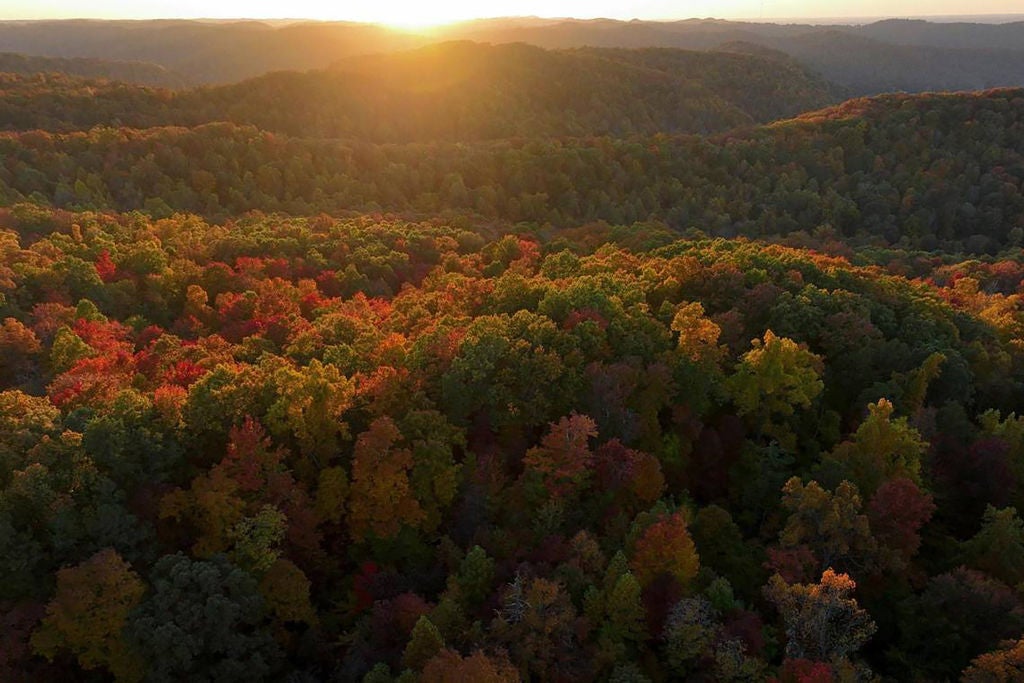Temperatures aren’t the only transformation taking place across the country, as the annual fall foliage event is also in full swing.The transition marks the time when spectacular photos can be taken of the vibrant red, yellow and orange colors.However, the timing and intensity of the annual event vary significantly across the country, with weather conditions playing a crucial role in determining the peak season.For instance, regions that experience a lack of precipitation are likely to see more muted colors, with leaves potentially turning brown and falling prematurely.Similarly, areas that endure a rainy and blustery fall may find their foliage season shortened, preventing it from reaching its full potential.WHAT ARE THE ODDS OF A WHITE HALLOWEEN?The vibrant colors of fall leaves are influenced not only by chlorophyll but also by weather conditions throughout the summer and early fall. Chlorophyll is the green pigment essential for photosynthesis, allowing trees to convert sunlight into energy.As chlorophyll breaks down in autumn, it reveals the beautiful yellows, oranges and reds beneath, especially after periods of ample rain.Weather patterns play a crucial role in this transformation. Excessive dryness or wetness can disrupt the typical progression of fall foliage, leading to less vivid colors.The fall color change starts in high-altitude regions of Alaska around mid-August and gradually moves southward, with areas along the Gulf Coast experiencing their peak color shifts in late November or early December.The most widespread changing of leaves is taking place throughout the Rockies but stands to pick up the pace over the next few weeks as the country heads into astronomical fall.WHY IS THE PUMPKIN A SYMBOL OF FALL AND HALLOWEEN?An easy way to remember or categorize the leaf-changing process is by interstates.Because of the Interstate Highway System, even-numbered roadways run east to west across the country, with Interstate 94 on the northern end and Interstate 10 being the southernmost thoroughfare.The first benchmark for leaf lovers is Interstate 90, which spans over 3,000 miles from Seattle to Boston. Communities along and north of I-90 are usually the first to see leaf changes, peaking in mid-October.Further south, along I-70, leaves typically start to change by the end of September, with their peak occurring around Halloween. The interstate runs over 2,000 miles from Utah through Maryland and traverses stunning terrain in Colorado.A highway corridor that usually sees the last leaf changes is Interstate 10, which runs from southern California to Jacksonville, Florida. Spotty colors begin to appear by the end of October, with a peak in late November and early December.Due to the corridor’s humid, subtropical climate, which is heavily influenced by the Gulf of Mexico, the region is not known for its leaf peeping. In fact, many residents venture northward, away from the Interstate 10 zone, to see the sights in more northern latitudes.A study by experts at Appalachian State University estimated the annual economic impact of foliage in classic sightseeing areas around the country was around $30 billion – a figure that many don’t discount.Tourism experts in Michigan say fall foliage viewing accounts for nearly 25% of the state’s tourist economy, and in Maine, millions usually visit the state between September and November to see the sights of the leaves.Data provided by Explorefall.com shows a significant increase in colors that are expected over the next week.Some higher elevations in New England could reach peak activity before the month is out.Widespread changes aren’t expected to reach the bigger cities along the I-95 corridor until October.The Midwest is lagging behind other regions, but looks can be deceiving.The region typically drastically changes in October when cooler air and less sunshine is available.The first areas to usually reach peak activity are in Minnesota, with Wisconsin and Michigan usually to follow.Some mountains have already reached peak activity across the western U.S. with more areas expected to be added to the foliage map in the coming weeks.The region typically is one of the first to see peak activity before winter sets in.Excellent viewing usually exists along the Continental Divide but will soon work its way down to lower elevations.







